Let’s Visit the Omori Shell Mounds
—the Birthplace of Archaeology in Japan
Omori Shell Mounds Park

Park entrance
 |
| Bust of Dr. Morse |
An American zoologist, Dr. Edward Sylvester Morse, discovered and excavated the Omori shell mounds in 1877. Today, the mounds and surrounding area are maintained as Omori Shell Mounds Park. Since the excavation Dr. Morse led was the first scientific excavation in Japan, these shell mounds are considered the birthplace of Japanese archaeology. The shell mounds are an ancient dump site, and various objects other than shells—such as animal bones, earthenware vessels and stone implements—have been discovered here. A number of these items are on display at the Shinagawa Historical Museum.
Upon entering the park, you will walk through rich natural greenery that surrounds the gentle slope that winds its way into the grounds. The park is a popular spot for viewing cherry blossoms in the spring. It also features Jomon Plaza, where mist comes up from the ground, an exhibition facility that incorporates an actual shell mound, and an area where visitors can learn about the Jomon Period of Japanese history, making the park both an oasis for community residents and a place where children can learn. Morse Plaza features a bust in praise of the good doctor’s achievements and a monument commemorating the signing of a sister-city agreement between Dr. Morse’s birthplace, Portland, Maine, and Shinagawa City. The sister cities will celebrate the thirtieth anniversary of their connection in October this year.
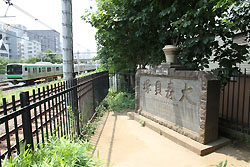 |
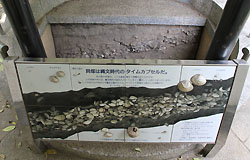 |
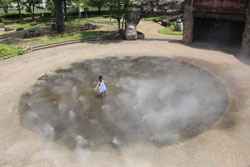 |
| Omori shell mounds stone monument, located beside the Tokaido Line |
Shell mound exhibit |
Jomon Plaza |
<Omori Shell Mounds Park>
Location: 6-21 Oi
Hours: 9:00 a.m. to 5:00 p.m. (until 6:00 p.m. from July through August; until 4:00 p.m. from November through February)
How to get there: Take the Tokyu Bus from Oimachi Station going to Ikegami Station or Kamata Station, and get off at the Omori-Soshajo bus stop; the park is also a five-minute walk from the north exit of Omori Station.
Shinagawa Historical Museum
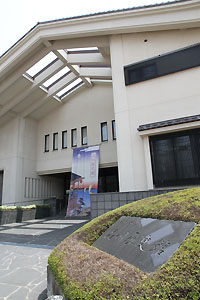
Shinagawa Historical Museum
The Shinagawa Historical Museum is a five-minute walk from Omori Shell Mounds Park. The museum was opened with the goal of enhancing the cultural life of Shinagawa residents, and conserves and displays historical materials and objects important to the city. At the permanent exhibition, which mainly spotlights Shinagawa-shuku, meaning the local post station (which prospered as the first such stop along the Tokaido Road) and the Omori shell mounds, visitors can learn about the history of Shinagawa from primitive times to the modern era.
There is also a grassy area in the center of the Shinagawa Historical Museum’s garden, with trees displaying the colors of the season, such as plum blossoms, cherry blossoms and autumn leaves. In addition, visitors can enjoy the harp-like sounds of suikinkutsu (an upside-down stone basin). The drawing room that faces the garden can also be used for traditional cultural activities such as the tea ceremony.
Note: There is a pamphlet in English that summarizes information on the historical museum and on Dr. Morse and the Omori shell mounds. In addition, there are thirty different explanation sheets (in Japanese only) that cover the Shinagawa Historical Museum’s permanent exhibition.
<Shinagawa Historical Museum>
Location: 6-11-1 Oi
Tel: 3777-4060
Hours: 9:00 a.m. to 5:00 p.m. (admission until 4:30 p.m.)
Closed: Mondays, national holidays (if a national holiday falls on a Sunday, the museum is open; if a national holiday falls on a Monday, the museum is closed that day and the following day), and during the year-end/New Year holidays
Note: There are also extra holidays, such as when the exhibits are being changed. The next holidays are from October 6 (Mon.) through 11 (Sat.).
Admission: 100 yen for adults, 50 yen for elementary/junior high school students
Note: Free of charge for elementary and junior high school students who live in Shinagawa City or go to a Shinagawa municipal school, those 70 years of age or older, and the disabled.
How to get there: Take the Tokyu Bus from Oimachi Station going to Ikegami Station or Kamata Station, and get off at the Kashima-Jinja-mae bus stop. Also a ten-minute walk from the north exit of Omori Station or a thirteen-minute walk from Tachiaigawa Station.
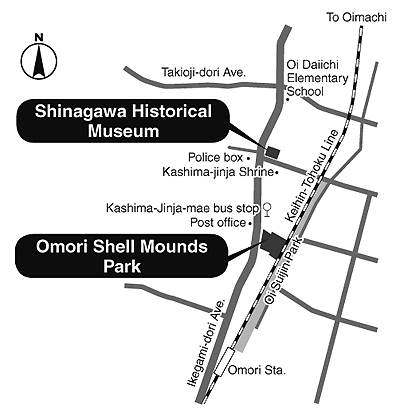
Shinagawa Historical Museum Special Exhibition:
From Shinagawa to the World—Samurai Crossing the Sea
After Commodore Matthew C. Perry’s arrival in Japan in 1853 and the signing of the Japan-US Treaty of Peace and Amity the following year, the Edo Shogunate and the subsequent Meiji government dispatched various emissaries to Europe and America. Shinagawa served as the port of departure and arrival for the emissaries who shaped Japan’s rapid modernization. This special exhibition traces the footsteps of the people who traveled around the world through Shinagawa.
Date: October 12 (Sun.) through November 30 (Sun.)
Admission: 300 yen for adults; 100 yen for elementary and junior high school students
Note: Free of charge for elementary and junior high school students who live in Shinagawa City or go to a Shinagawa municipal school, residents 70 years of age or older, and disabled residents
Closed: October 14 (Tue.), 20 (Mon.), and 27 (Mon.) and November 4 (Tue.), 10 (Mon.), 17 (Mon.), and 25 (Tue.) |








